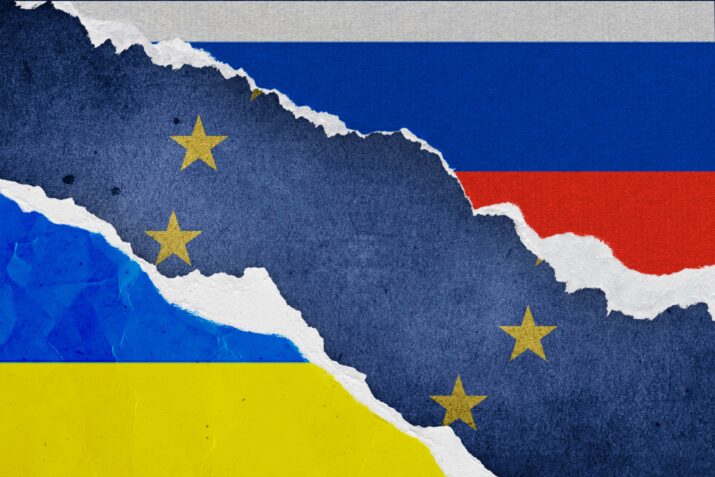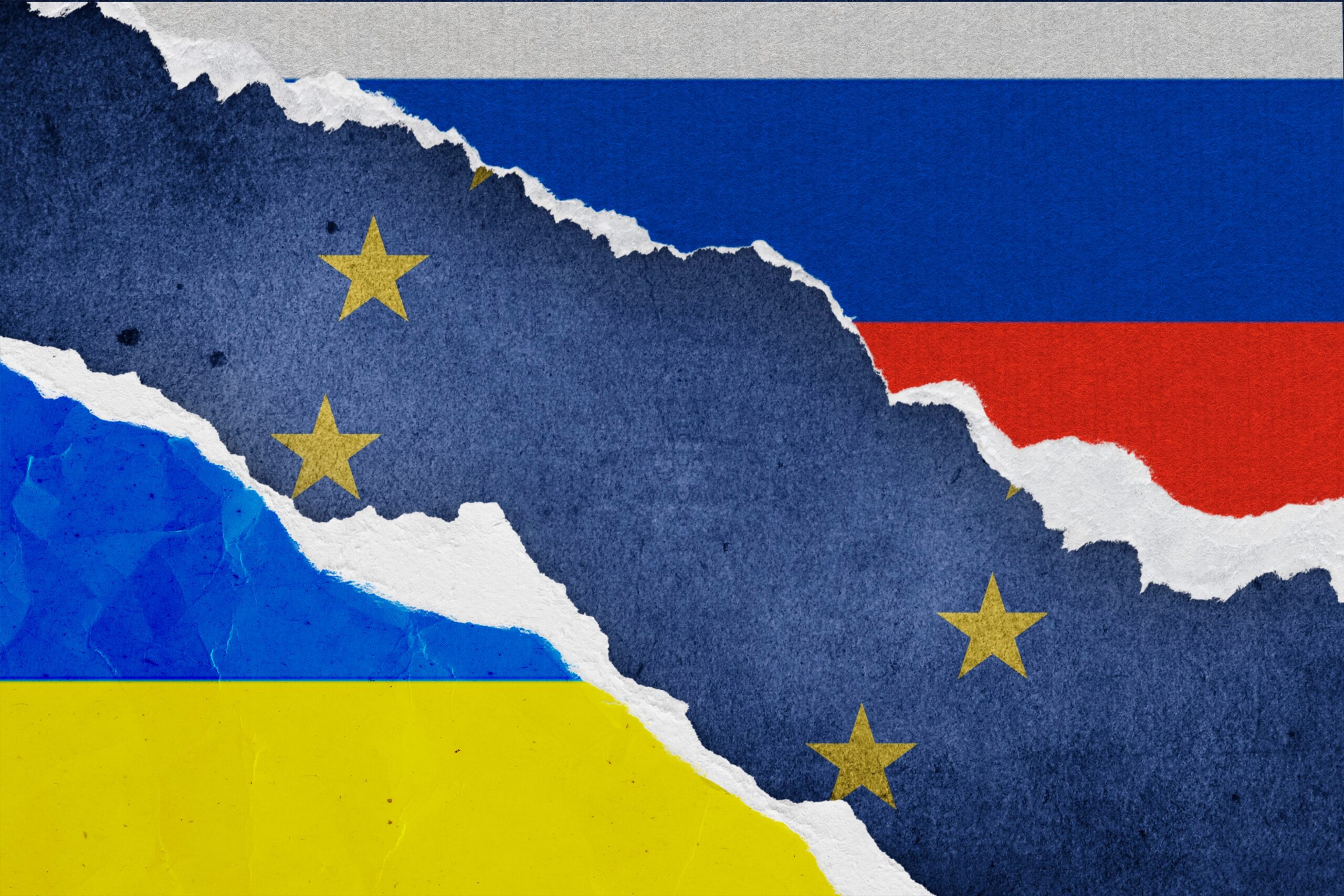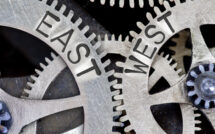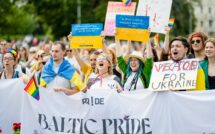

This is part of our special feature, Europe and NATO Since Ukraine.
Russia’s invasion of Ukraine—called “special military operation” in Russia—began on February 24, 2022. At the beginning, both the Russian and European populations were surprised, thinking that Ukraine would easily fall in Russian hands and that a puppet regime in Kyiv was in the making. After some time, Russians and Europeans came to perceive the outcome of the war as unclear and think that the invasion followed no clear plan. However, at that time, the vague notion that Ukraine would be quickly subjugated still prevailed. Then, the Ukrainian counteroffensive began and was rather successful. So that, at present, the war has become completely stalemated and its outcome remains uncertain.
The war between Ukraine and Russia can best be understood as the result of a profound shift over the last thirty years—since the fall of the Soviet Union—in the relationship between Russia and Europe, particularly the European Union (EU). While today President Putin proclaims that Russia and Europe are inherently antagonistic, in the 1990s and early 2000s, Russia had largely friendly relations with the EU as well as with NATO. Good relations with Europe, however, depended, in part, on Ukraine lying in Russia’s sphere of influence. Once Putin began to fear that Ukraine would move out of the “grey zone” between Russia and Europe and would be welcomed in the EU, relations began to deteriorate. Examining the policies pursued and the actions taken in Putin’s Russia and the EU can thus illuminate why the war broke out and why the stalemate is unlikely to be resolved.
Following the fall: Yeltsin and the opening to the West
Many in the West—Europeans included—thought that after the fall of the Soviet Union, few dangers from Russia were to be feared. During the 1990s, under Boris Yeltsin’s presidency, this was indeed the case. During that time, Russia’s foreign policy was very much oriented toward the West. In 1997, a partnership and co-operation agreement (PCA) was established between Russia and the EU, and in 1998, Russia was even admitted to the G7, which, through informal “diplomacy without neckties” gathers the leaders of the wealthiest countries in the world. However, also during Yeltsin’s presidency, the notion of a “near abroad” emerged to describe a former Soviet zone that had not been able to free itself from Russian “influence.” For Moscow, Russians in that near abroad—which included the Baltic countries—were in fact under the “protection” of Russia. The regions of Abkhazia, South-Ossetia, and Transnistria had already been separated from Georgia and Moldova and occupied by Russian troops. Aside from the near abroad, another concept Yeltsin introduced, notably in his 1993 constitution, was “super-presidentialism,” through which extensive powers were granted to the president over both the executive and legislative branches of government. Another important event in the recent history of Russia is that on the last evening of 1999, Yeltsin designated as his successor Vladimir Putin, who had been his prime minister since August 1999. These events certainly contributed much to Putin’s ascendancy as the virtual dictator that he is today.
Already in 1994 Yeltsin had spoken of a “Cold Peace.” From the Russian perspective, the Cold War had resulted in a fundamental imbalance between Russia and the West. Whereas the Warsaw Pact and the Soviet Union were both dissolved after the Cold War, NATO expanded to include new member states located mainly in Eastern Europe, i.e., the former Soviet bloc. Moreover, other tensions lay beneath the surface, such as the nuclear question. Russia, generally seen as heir to the Soviet Union, had inherited its nuclear weapons, part of which were positioned in Ukraine, Belarus, and Kazakhstan. These three countries destroyed these weapons—with the support of the US and other nuclear powers—or returned them to Russia in exchange for their territorial integrity being guaranteed, which Russia would not respect in practice.
The rise of Putin in Russia
In the 1990s, Putin wrote his thesis at the University of Saint Petersburg—a thesis that has since been shown to have been mainly copied from an American guidebook—arguing that Russia should use its energy riches as a strategic tool. As soon as Putin took over from Yeltsin, he indeed worked to increase the West’s energy dependence on Russia. Trends on the international oil market worked greatly in his favor: in August 1999, around the time Putin became prime minister, a barrel of oil cost $15, and at the end of Putin’s second presidential term in 2008, the price had reached $100. As Putin wanted to remake Russia into a superpower, he viewed the former Soviet zone as a Russian sphere of influence. Expressing his Soviet nostalgia in 2005, he described the fall of the Soviet Union as the “greatest geopolitical catastrophe of the twentieth century.”[1] This nostalgia led him to promote “militocracy” in Russia’s governance as soon as he was in power. Under this regime, siloviki (ex-KGB officers, state security agents, or army officers) played a prominent role.[2] Putin—himself a former KGB—officer—had directed the Federal Security Service (FSB), the successor of the KGB, before becoming prime minister. However, during the first years of his presidency, Putin sought to consolidate his power by adopting a pro-Western course. He was pragmatic in thinking that Russia should not enter into conflicts it could not win for lack of a solid economy—a view President George W. Bush shared. In fact in June 2001, Bush announced that he had looked into Putin’s eyes and that he could trust him;[3] and in the summer of 2006, Putin would even host the G8 leaders in Saint Petersburg.
However, after several years in power, Putin started to change course. For example, by 2003, he had already turned against the American Iraq campaign. More importantly, starting in 2005, Putin sharpened his rhetoric, criticizing the nineties as the years of “wild capitalism.” This rhetoric coincided with public opinion in Russia, as Russians identified the disintegration of the Soviet system and the decline in their day-to-day security as the sources of Russia’s difficulties. In addition, the former Soviet sphere experienced a series of revolutions in the 2000s—the so-called “color revolutions.” In 2003, the Rose Revolution occurred in Georgia, while the Orange Revolution took place in Ukraine in late 2004; and the Tulip Revolution shook Kyrgyzstan in 2005. These transformations were generally welcomed and supported by the West but posed a threat to the way Putin sought to consolidate political power in Russia. In response, domestic politics in Russia took an oppressive turn, and Russian foreign policy became explicitly anti-Western.
On February 10, 2007, Putin gave a speech in Munich in which he criticized the US for its “almost uncontained hyper use of force in international relations.”[4] Mainly, he opposed the US’s project to build an anti-missile shield in certain East European countries. However, as time went on, Moscow increasingly criticized the Western-led post-Cold War international order. Nonetheless, in April 2008 Putin was invited to NATO’s Bucharest summit, where alliance leaders discussed whether Georgia and Ukraine should become NATO members—an idea Bush supported. Eventually, due in part to Putin’s strong opposition, this proposal was postponed indefinitely.
On the energy question, the 2000s saw Europe becoming increasingly dependent on Russia for its energy supply. Until 2022, Europe imported at least a quarter of its oil and 15 percent of its natural gas from Russia. Therefore, it can be said that to a certain extent Europe financed the Russian invasion of Ukraine. In 2005, Germany concluded an agreement with Russia’s Gazprom for the construction of Nord Stream-1—a pipeline going through the Baltic Sea. Poland and the Baltic countries were strongly opposed to the project, as they found themselves bypassed and did not support Europe’s increasing energy dependence on Russia. At that time, European-Russian relations became characterized by Wandel durch Handel, or “change through trade.” Until Russia annexed Crimea in 2014, Europe remained Russia’s greatest trading partner and supplied two-thirds of its foreign investments.
Ukraine in the EU and NATO
In the 2010s, Ukraine concluded an association agreement (AA) with the EU to circumvent the controversy that moving toward full EU membership status might provoke in Russia. In fact, initially, Russia did not signal any discontent to the EU about the agreement; and for European leaders, Ukraine was not to sever its ties with Russia nor orient itself completely towards the EU. However, although he first supported this agreement, Ukraine’s pro-Russian president Viktor Yanukovych then refused to sign it in the fall of 2013, as Putin made him a more favorable proposition. At that time, many Ukrainians nourished hopes that the agreement would lead to domestic reforms that could help Ukraine move away from oligarchy and away from Yanukovych’s and his associates’ authoritarian kleptocracy. On November 21, 2013, tens of thousands again filled Maidan Square in the center of Kyiv to protest against Yanukovych. For Russia, this movement had been planned and financed by the West; and Yanukovych, encouraged by Putin, attempted to organize the opposition, which only added fuel to the fire. As the regime’s response to the demonstrations grew ever more violent, in February 2014 snipers killed dozens of people on Maidan Square. In an effort to ease the crisis, European leaders tried to mediate a deal for Ukraine to hold anticipated presidential elections. Yanukovych was voted out, and a new government was installed with the support of the vast majority of Yanukovych’s own Party of Regions and the Maidan movement. Yanukovych soon fled in fear of the popular fury and eventually went into exile in Russia. Moscow immediately declared Yanukovych’s downfall to be an illegal putsch, calling the new government a “junta” of “fascists” and “neo-Nazis.” Putin saw the downfall of Yanukovych as the first step toward Ukraine breaking away from Russia and aligning with the EU and ultimately with NATO. Consequently, he ordered the Russian annexation of Crimea and, over the following months, Russia would launch a “hybrid war” in the Donbas region using local Russian speakers’ antagonism with Kyiv as a way to undermine support for the new Ukrainian government. While the international community, led by the EU and NATO, emphatically condemned both the annexation and the covert war in the Donbas region, the EU pressured the Ukrainian army not to resist in Crimea; thus, the Ukrainian resistance started only later. In May 2014, Ukraine elected a new president, Petro Poroshenko, who signed the AA with the EU and agreed to a ceasefire with the Donbas separatists through the Minsk Protocol, or “Minsk-1.” However, none of the parties abided by the protocol’s clauses, and while the armistice was confirmed and completed as “Minsk-2” in February 2015, violence did not stop. Between 2014 and the Russian invasion of 2022, approximately 14,000 people were killed in the Donbas war.
Russian rhetoric on Europe after the Crimean annexation
The aftermath of the Crimean annexation differed sharply from what Putin had envisaged during the first years of his presidency, when he still claimed to want to integrate Russia with Europe and to form a free trade zone with European partners. In the eyes of most European leaders, the annexation of Crimea and the covert war in the Donbas meant that Putin had unsettled the international post-World War II order and endangered peace. Thus, EU leaders ended the summit talks that had been held with Russia twice a year since 1998. To punish Russia, European leaders introduced sanctions against Putin. However, the EU did not address the energy question. Instead, Europe became even more dependent on Russian energy, and a second gas pipeline was even constructed after 2014—Nord Stream-2. In reaction to European sanctions, Russia turned against Europe and in turn imposed sanctions on Europe. Russian propagandists then began referring to Europe as “Gayropa”—a place where “traditional values” had fallen into oblivion. Thanks to this type of rhetoric, Russia gathered the support of populists in the West, mainly Eurosceptic groups and parties on both the extreme left and right. In fact, today Russia prefers to negotiate with individual EU countries—at least as long as they are critical of the European Commission—rather than with the European Commission. Moreover, Russian leaders have attempted to compensate for Russia’s estrangement from the West by operating a rapprochement with non-aligned countries, especially China.
In July 2021, Putin provided a detailed historical discourse on the relationship between Ukraine and Russia, in which he argued that Ukraine could only be an independent nation if closely associated with Russia. He also blamed the US and the EU for Ukraine wanting to choose its own partners and alliances. In fact, from Moscow’s perspective, Ukrainians who have supported independence and alignment with the West since the beginning of the war are merely pawns in a US-led Western campaign to weaken Russia—an “anti-Russia project.”[5]
Volodymyr Zelensky’s Ukraine
Until the early 2020s, Ukraine had been excluded from the prospect of EU membership. However, under Volodymyr Zelensky— Poroshenko’s successor—it became a candidate member in June 2022. On October 2, 2023, the EU’s ministers of foreign affairs assembled in Kyiv, which was the first time they ever met outside of Belgium. However, Hungary and Slovakia did not attend. Hungary—led by Viktor Orbán—had long been an outsider for the EU, whereas in Slovakia, Robert Fico’s pro-Russian party (Smer) had just won the parliamentary elections. Because other countries within the EU also stand against Ukraine on various issues, it has been difficult for the EU to show unity in support of Ukraine.
In October 2023, EU leaders debated whether emphasis should be placed on welcoming new candidate-members or on a geopolitical course that could enable the EU to serve as a counterweight to Russia, China, or the US. Some EU leaders took the position that the new candidate-member states should first fulfill the many conditions of EU membership. Connected to this question was the issue of the sharing of EU funds across an increased number of member states, causing the richer EU countries to bear most of the financial burden. Ursula von der Leyen, the president of the European Commission, moved ahead of these debates and promised the Ukrainian parliament that, if Ukraine continued current reforms, negotiations about its EU membership could start at the end of 2023, a decision Orbán threatened to veto.
Putin in the face of Ukraine’s potential NATO and EU membership
These and similar debates within the NATO alliance about possible membership for Ukraine do not put the West in a positive light. In January 2023, Putin reiterated that Russia’s domestic politics and foreign relations should be connected and that, in the end, Russia’s fight is with the West. Indeed, or Putin, the West seeks to “destroy Russian statehood” and uses Ukraine to do its fighting.[6] Moreover, Russia appears to have succeeded in mitigating the worst effects of Western sanctions, on the one hand by strengthening economic ties with the likes of China and India and on the other hand by intensifying its military collaboration with Iran and North Korea. At the same time, there continue to be signs that not all is quiet on Putin’s home front. Protests against the war, however small, keep erupting in spite of the state’s repression; for example, protests of mothers and wives of men serving on the front lines have grown relentlessly. Moreover, while the semi-independent Wagner Group and its leader Yevgeny Prigozhin have been eliminated as a direct threat to Putin’s power, the memory of their violent and unexpected uprising last summer remains and serves as a reminder that even close members of Putin’s circle can turn against him.
The war in Ukraine today and what to expect
Putin has refused to accept an independent Ukraine; he has also rejected the West in general, and the EU in particular, perceiving both as anything but enemies. In parallel, European leaders have not changed their position regarding the Russian war against Ukraine. However, the most recent war between Israel and Hamas that started in October 2023 has created a second front for the West. Therefore, the future decisions of the EU and the US about their funding allocation for these two conflicts will be decisive for Ukraine’s fight against Russia and effort to reclaim its southern territories. Obviously, a weakened Ukrainian resistance would open the road for a Russian victory; but a Ukrainian defeat would also be a major defeat for the West.
In October 2023, Time Magazine published an article whose tenor is captured in the following words: “They [the Western allies] have left [Zelensky] without the means to win the war, only the means to survive it.”[7] These words provoked a negative reaction among Ukrainians. For example, Tymofiy Mylovanov, the president of the Kyiv School of Economics, reacted on X that “It seems American media still think that Ukraine’s fate is for Washington and Moscow to decide, not for us, Ukrainians.”[8] In fact, Ukraine’s recent military actions show that its desire is to keep fighting in the hope to win or force Putin into accepting a significant withdrawal from Ukraine. In this pursuit, Zelensky again visited Washington in December 2023 to ask for major assistance from the West.
On the other side of the conflict, Russia’s 2024 budget, of which one third is allocated to the military, is a good indication that the Russian government is ready for a long war and demonstrates Putin’s determination to risk his country’s prosperity to focus on the war. This situation is unlikely to change in any fundamental way as long as he and his vision for Russia’s place in the world dominate Moscow’s policy. Furthermore, if peace negotiations between Ukraine and Russia were to start today, Ukraine would almost certainly have to relinquish over 15 percent of its territory, since Russia is unlikely to withdraw from those areas it already controls. Therefore, continued Russian occupation of Ukrainian territories, even if temporarily accepted by Ukraine, would leave open the possibility of a future territorial war between the two countries.
Marc Jansen was a senior lecturer at the University of Amsterdam, first at the Eastern European Institute, and in the 2000sthen in the European Studies Program. In the late 1980s he worked in the Moscow archives on a project published (with Nikita Petrov) as Stalin’s Loyal Executioner: People’s Commissar Nikolai Ezhov, 1895-1940 (Hoover Institution Press, 2002). He was also a collaborator at the International Institute of Social Studies (Amsterdam) in the 1980s. Among his many Dutch-language publications is Grensland: een geschiedenis van Oekraine (Van Oorschot, 2014). He retired in 2011.
[1] “Putin: Soviet Collapse a ‘Genuine Tragedy.’” Via the Associated Press, April 25, 2005. nbcnews.com/id/wbna7632057
[2] Olga Kryshtanovskaya and Stephen White, “Putin’s Militocracy,” Post-Soviet Affairs, 19:4 (2003), 289-306.
[3] User Clip: Bush saw Putin’s soul. June 17, 2001. https://www.c-span.org/video/?c4718091/user-clip-bush-putins-soul
[4] “Speech and the Following Discussion at the Munich Conference on Security Policy,” February 10, 2007.
President of Russia website, http://en.kremlin.ru/events/president/transcripts/24034
[5] Vladimir Putin, “On the Historical Unity of Russians and Ukrainians.” July 12, 2021. http://en.kremlin.ru/events/president/news/66181
[6] Burc Eruygur, “Putins says West is Russia’s enemy, not Ukraine itself: ‘This has been the case for centuries and continues today,’ says Russian president,” Anadolu Agency 01.01.2024. https://www.aa.com.tr/en/europe/putin-says-west-is-russia-s-enemy-not-ukraine-itself-/3097577
[7] “Nobody believes in our victory like I do. Nobody.” (a Zelensky quotation). Time Magazine, October 30, 2023, updated November 1: time.com/6329188/ukraine-volodymyr-zelensky-interview/
[8] Tweet (now X) of the Ukrainian Timofiy Mylovanov, November 1, 2023. https://twitter.com/Mylovanov/status/1719489816297947413
Published on February 15, 2024.




